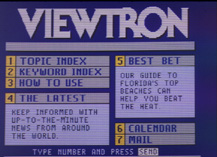
CP/M, originally standing for Control Program/Monitor and later Control Program for Microcomputers, is a mass-market operating system created in 1974 for Intel 8080/85-based microcomputers by Gary Kildall of Digital Research, Inc. CP/M is a disk operating system and its purpose is to organize files on a magnetic storage medium, and to load and run programs stored on a disk. Initially confined to single-tasking on 8-bit processors and no more than 64 kilobytes of memory, later versions of CP/M added multi-user variations and were migrated to 16-bit processors.

A light pen is a computer input device in the form of a light-sensitive wand used in conjunction with a computer's cathode-ray tube (CRT) display.
NAPLPS is a graphics language for use originally with videotex and teletext services. NAPLPS was developed from the Telidon system developed in Canada, with a small number of additions from AT&T Corporation. The basics of NAPLPS were later used as the basis for several other microcomputer-based graphics systems.

Telidon was a videotex/teletext service developed by the Canadian Communications Research Centre (CRC) during the late 1970s and supported by commercial enterprises led by Infomart in the early 1980s. Most work on the system ended after 1985, having failed to build critical mass.

Videotex was one of the earliest implementations of an end-user information system. From the late 1970s to early 2010s, it was used to deliver information to a user in computer-like format, typically to be displayed on a television or a dumb terminal.

MSX is a standardized home computer architecture, announced by ASCII Corporation on June 16, 1983. It was initially conceived by Microsoft as a product for the Eastern sector, and jointly marketed by Kazuhiko Nishi, the director at ASCII Corporation. Microsoft and Nishi conceived the project as an attempt to create unified standards among various home computing system manufacturers of the period, in the same fashion as the VHS standard for home video tape machines. The first MSX computer sold to the public was a Mitsubishi ML-8000, released on October 21, 1983, thus marking its official release date.

The Minitel was a videotex online service accessible through telephone lines, and was the world's most successful online service prior to the World Wide Web. It was invented in Cesson-Sévigné, near Rennes, Brittany, France.

Bildschirmtext was an online videotex system launched in West Germany in 1983 by the Deutsche Bundespost, the (West) German postal service.

Prestel, the brand name for the UK Post Office Telecommunications's Viewdata technology, was an interactive videotex system developed during the late 1970s and commercially launched in 1979. It achieved a maximum of 90,000 subscribers in the UK and was eventually sold by BT in 1994.

The Philips P2000T home computer was Philips' first real entry in the home computer market in 1980, after the Philips Videopac G7000 game system which they already sold to compete with the Atari 2600 and similar game systems. There was also a P2000M version with an additional 80-column text card for use with a monochrome monitor. This version shipped with a monitor cabinet also housing a dual 5¼-inch floppy disk drive. The P2000C version, introduced in 1982, was portable.

ASCII Corporation, Ltd. was a Japanese publishing company based in Chiyoda, Tokyo. It became a subsidiary of Kadokawa Group Holdings in 2004, and merged with another Kadokawa subsidiary MediaWorks on April 1, 2008, becoming ASCII Media Works. The company published Monthly ASCII as the main publication. ASCII is best known for creating the Derby Stallion video game series, the MSX computer, and the RPG Maker line of programming software.
Antiope was a French teletext standard in the 1980s. It also formed the basis for the display standard used in the French videotex service Minitel. The term allegedly stood for Acquisition Numérique et Télévisualisation d’Images Organisées en Pages d’Écriture, which could be loosely translated as Digital Acquisition and Remote Visualization of Images Organized into Written Pages.

Mitsubishi Electric Corporation is a Japanese multinational electronics and electrical equipment manufacturing company headquartered in Tokyo, Japan. It was established in 1921 as a spin-off from the electrical machinery manufacturing business of Mitsubishi Shipbuilding at the Kobe Shipyard. The products from MELCO include elevators and escalators, high-end home appliances, air conditioning, factory automation systems, train systems, electric motors, pumps, semiconductors, digital signage, and satellites.

Alex was an interactive videotex information service offered by Bell Canada in market research from 1988 to 1990 and thence to the general public until 1994.

Teletext, or broadcast teletext, is a standard for displaying text and rudimentary graphics on suitably equipped television sets. Teletext sends data in the broadcast signal, hidden in the invisible vertical blanking interval area at the top and bottom of the screen. The teletext decoder in the television buffers this information as a series of "pages", each given a number. The user can display chosen pages using their remote control. In broad terms, it can be considered as Videotex, a system for the delivery of information to a user in a computer-like format, typically displayed on a television or a dumb terminal, but that designation is usually reserved for systems that provide bi-directional communication, such as Prestel or Minitel.

Bomberman is a maze video game developed and published by Hudson Soft. The original home computer game Bomber Man was released in July 1983 for the NEC PC-8801, NEC PC-6001 mkII, Fujitsu FM-7, Sharp MZ-700, Sharp MZ-2000, Sharp X1 and MSX in Japan, and a graphically modified version for the MSX and ZX Spectrum in Europe as Eric and the Floaters. A sequel, 3-D Bomberman, was produced. In 1985, Bomberman was released for the Nintendo Entertainment System. It spawned the Bomberman series with many installments building on its basic gameplay.

Viewtron was an online service offered by Knight-Ridder and AT&T from 1983 to 1986. Patterned after the British Post Office's Prestel system, it started as a videotex service requiring users to have a special terminal, the AT&T Sceptre. As home computers became important in the marketplace, the development focus shifted to IBM, Apple, Commodore and other personal computers.

Home computers were a class of microcomputers that entered the market in 1977 and became common during the 1980s. They were marketed to consumers as affordable and accessible computers that, for the first time, were intended for the use of a single, non-technical user. These computers were a distinct market segment that typically cost much less than business, scientific, or engineering-oriented computers of the time, such as those running CP/M or the IBM PC, and were generally less powerful in terms of memory and expandability. However, a home computer often had better graphics and sound than contemporary business computers. Their most common uses were word processing, playing video games, and programming.
The AT&T Sceptre was a graphical terminal launched by AT&T in October 1983, used for the two largest deployments of videotex in the United States: Knight Ridder's Viewtron service in Florida, and the Los Angeles Times' Gateway service in Southern California. The Sceptre was the basic bit of home kit needed for the services, to paint NAPLPS-standard geometrically-specified pages to the screen.

BraSCII is an encoded repertoire of characters that was used in Brazil. It was used in the 1980s on several printers, in applications like Carta Certa, in video boards and it was the standard character set in the Brazilian line of MSX computers. This code page is known by Star printers as Code page 3847.






















